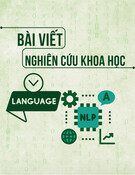
BM-003
Trang 1 / 16
TRƯỜNG ĐẠI HỌC VĂN LANG
ĐƠN VỊ: KHOA NGOẠI NGỮ
ĐỀ THI VÀ ĐÁP ÁN
THI KẾT THÚC HỌC PHẦN
Học kỳ 3, năm học 2023-2024
I. Thông tin chung
Tên học phần:
Đọc 3
Mã học phần:
71ENGL30392
Số tín chỉ:
2
Mã nhóm lớp học phần:
233_71ENGL30392_01, 02
Hình thức thi: Trắc nghiệm kết hợp Tự luận
Thời gian làm bài:
60
phút
Thí sinh được tham khảo tài liệu:
☐ Có
☒ Không
1. Format đề thi
- Font: Times New Roman
- Size: 13
- Tên các phương án lựa chọn: in hoa, in đậm
- Không sử dụng nhảy chữ/số tự động (numbering)
- Mặc định phương án đúng luôn luôn là Phương án A ghi ANSWER: A
- Tổng số câu hỏi thi:
- Quy ước đặt tên file đề thi:
+ Mã học phần_Tên học phần_Mã nhóm học phần_TNTL_De 1
+ Mã học phần_Tên học phần_Mã nhóm học phần_TNTL_De 1_Mã đề (Nếu sử dụng
nhiều mã đề cho 1 lần thi).
2. Giao nhận đề thi
Sau khi kiểm duyệt đề thi, đáp án/rubric. Trưởng Khoa/Bộ môn gửi đề thi, đáp án/rubric
về Trung tâm Khảo thí qua email: khaothivanlang@gmail.com bao gồm file word và file pdf
(nén lại và đặt mật khẩu file nén) và nhắn tin + họ tên người gửi qua số điện thoại
0918.01.03.09 (Phan Nhất Linh).
- Khuyến khích Giảng viên biên soạn và nộp đề thi, đáp án bằng File Hot Potatoes. Trung
tâm Khảo thí gửi kèm File cài đặt và File hướng dẫn sử dụng để hỗ trợ Quý Thầy Cô.

BM-003
Trang 2 / 16
II. Các yêu cầu của đề thi nhằm đáp ứng CLO
(Phần này phải phối hợp với thông tin từ đề cương chi tiết của học phần)
Ký hiệu
CLO
Nội dung CLO
Hình thức
đánh giá
Trọng số
CLO trong
thành phần
đánh giá
(%)
Câu hỏi
thi số
Điểm số
tối đa
Lấ,y dữ liệu
đo lường mức
đạt PLO/PI
(1)
(2)
(3)
(4)
(5)
(6)
(7)
CLO1
Áp dụng từ vựng
đã học một cách
linh hoạt trong
tình huống cụ
thể
Trắc
nghiệm
20%
Phần
III (từ
câu 1
đến 8)
2 đ
PI 2.2
CLO2
Vận dụng quy
trình đọc hiểu
vào các bài đọc
học thuật có độ
dài từ 500 đến
dưới 1.000 từ
Tự luận
+ Trắc
nghiệm
20%
Phần I
(từ câu
1 đến
câu 6)
3đ
PI 2.2
CLO3
Đọc lướt lấy ý
chính và đọc
hiểu chi tiết các
bài đọc học thuật
từ 500 đến 1.000
từ
Tự luận
+ Trắc
nghiệm
40%
- Phần
II
(từ câu
1 đến
câu 5)
- Phần
IV (từ
câu 1
đến
câu 7)
4,25 đ
PI 4.1
CLO4
Đọc hiểu ẩn ý
trong các bài đọc
Tự luận
+ Trắc
nghiệm
20%
- Phần
II (câu
6)
- Phần
IV
(câu 8)
0,75 đ
PI 4.1
Chú thích các cột:
(1) Chỉ liệt kê các CLO được đánh giá bởi đề thi kết thúc học phần (tương ứng như đã mô tả trong
đề cương chi tiết học phần). Lưu ý không đưa vào bảng này các CLO không dùng bài thi kết thúc học
phần để đánh giá (có một số CLO được bố trí đánh giá bằng bài kiểm tra giữa kỳ, đánh giá qua dự
án, đồ án trong quá trình học hay các hình thức đánh giá quá trình khác chứ không bố trí đánh giá
bằng bài thi kết thúc học phần). Trường hợp một số CLO vừa được bố trí đánh giá quá trình hay giữa
kỳ vừa được bố trí đánh giá kết thúc học phần thì vẫn đưa vào cột (1)
(2) Nêu nội dung của CLO tương ứng.

BM-003
Trang 3 / 16
(3) Hình thức kiểm tra đánh giá có thể là: trắc nghiệm, tự luận, dự án, đồ án, vấn đáp, thực hành
trên máy tính, thực hành phòng thí nghiệm, báo cáo, thuyết trình,…, phù hợp với nội dung của CLO
và mô tả trong đề cương chi tiết học phần.
(4) Trọng số mức độ quan trọng của từng CLO trong đề thi kết thúc học phần do giảng viên ra đề
thi quy định (mang tính tương đối) trên cơ sở mức độ quan trọng của từng CLO. Đây là cơ sở để
phân phối tỷ lệ % số điểm tối đa cho các câu hỏi thi dùng để đánh giá các CLO tương ứng, bảo đảm
CLO quan trọng hơn thì được đánh giá với điểm số tối đa lớn hơn. Cột (4) dùng để hỗ trợ cho cột
(6).
(5) Liệt kê các câu hỏi thi số (câu hỏi số … hoặc từ câu hỏi số… đến câu hỏi số…) dùng để kiểm
tra người học đạt các CLO tương ứng.
(6) Ghi điểm số tối đa cho mỗi câu hỏi hoặc phần thi.
(7) Trong trường hợp đây là học phần cốt lõi - sử dụng kết quả đánh giá CLO của hàng tương ứng
trong bảng để đo lường đánh giá mức độ người học đạt được PLO/PI - cần liệt kê ký hiệu PLO/PI có
liên quan vào hàng tương ứng. Trong đề cương chi tiết học phần cũng cần mô tả rõ CLO tương ứng
của học phần này sẽ được sử dụng làm dữ liệu để đo lường đánh giá các PLO/PI. Trường hợp học
phần không có CLO nào phục vụ việc đo lường đánh giá mức đạt PLO/PI thì để trống cột này.
III. Nội dung câu hỏi thi
PHẦN TRẮC NGHIỆM (20 câu + 0,5đ/ câu – Phần I & II; 0,25đ/ câu – Phần III)
Part I: Read the passage below and match each given heading with each suitable
paragraph. (3 marks)
(A) In the 1970s, as part of a large-scale research program exploring the area of
Interspecies communication, Dr Francine Patterson from Stanford University attempted to
teach two lowland gorillas called Michael and Koko a simplified version of Sign Language.
According to Patterson, the great apes were capable of holding meaningful conversations, and
could even reflect upon profound topics, such as love and death. During the project, their
trainers believe they uncovered instances where the two gorillas' linguistic skills seemed to
provide reliable evidence of intentional deceit. In one example, Koko broke a toy cat, and
then signed to indicate that the breakage had been caused by one of her trainers. In another
episode, Michael ripped a jacket belonging to a trainer and, when asked who was responsible
for the incident, signed ‘Koko’. When the trainer expressed some skepticism, Michael
appeared to change his mind, and indicated that Dr Patterson was actually responsible, before
finally confessing.
(B) Other researchers have explored the development of deception in children. Some of
the most interesting experiments have involved asking youngsters not to take a peek at their
favorite toys. During these studies, a child is led into a laboratory and asked to face one of the
walls. The experimenter then explains that he is going to set up an elaborate toy a few feet

BM-003
Trang 4 / 16
behind them. After setting up the toy, the experimenter says that he has to leave the laboratory
and asks the child not to turn around and peek at the toy. The child is secretly filmed by hidden
cameras for a few minutes, and then the experimenter returns and asks them whether they
peeked. Almost all three-year-olds do, and then half of them lie about it to the experimenter.
By the time the children have reached the age of five, all of them peek and all of them lie.
The results provide compelling evidence that lying starts to emerge the moment we learn to
speak.
(C) So what are the tell-tale signs that give away a lie? In 1994, the psychologist Richard
Wiseman devised a large-scale experiment on a TV program called Tomorrow's World. As
part of the experiment, viewers watched two interviews in which Wiseman asked a presenter
in front of the cameras to describe his favorite film. In one interview, the presenter picked
Some Like It Hot and he told the truth; in the other interview, he picked Gone with the Wind
and lied. The viewers were then invited to make a choice - to telephone in to say which film
he was lying about. More than 30,000 calls were received, but viewers were unable to tell the
difference and the vote was a 50/50 split. In similar experiments, the results have been
remarkably consistent - when it comes to lie detection, people might as well simply toss a
coin. It doesn’t matter if you are male or female, young or old; very few people are able to
detect deception.
(D) Why is this? Professor Charles Bond from the Texas Christian University has
conducted surveys into the sorts of behavior people associate with lying. He has interviewed
thousands of people from more than 60 countries, asking them to describe how they set about
telling whether someone is lying. People’s answers are remarkably consistent. Almost
everyone thinks liars tend to avert their gaze, nervously wave their hands around and shift
about in their seats. There is, however, one small problem. Researchers have spent hour upon
hour carefully comparing films of liars and truth-tellers. The results are clear. Liars do not
necessarily look away from you; they do not appear nervous and move their hands around or
shift about in their seats. People fail to detect lies because they are basing their opinions on
behaviors that are not actually associated with deception.

BM-003
Trang 5 / 16
(E) So what are we missing? It is obvious that the more information you give away, the
greater the chances of some of it coming back to haunt you. As a result, liars tend to say less
and provide fewer details than truth-tellers. Looking back at the transcripts of the interviews
with the presenter, his lie about Gone with the Wind contained about 40 words, whereas the
truth about Some Like It Hot was nearly twice as long. People who lie also try psychologically
to keep a distance from their falsehoods, and so tend to include fewer references to themselves
in their stories. In his entire interview about Gone with the Wind, the presenter only once
mentioned how the film made him feel, compared with the several references to his feelings
when he talked about Some Like It Hot.
(F) The simple fact is that the real clues to deceit are in the words that people use, not the
body language. So do people become better lie detectors when they listen to a liar, or even
just read a transcript of their comments? The interviews with the presenter were also broadcast
on radio and published in a newspaper, and although the lie-detecting abilities of the television
viewers were no better than chance, the newspaper readers were correct 64% of the time, and
the radio listeners scored an impressive 73% accuracy rate.
Paragraph A _____
A. Do only humans lie?
B. When do we begin to lie?
C. How wrong is it to lie?
D. Exposing some false beliefs
E. Which form of communication best exposes a lie?
F. Some of the things liars really do
G. Dealing with known liars
H. A public test of our ability to spot a lie
ANSWER: A
Paragraph B _____
A. When do we begin to lie?
B. Some of the things liars really do
C. Exposing some false beliefs
D. How wrong is it to lie?

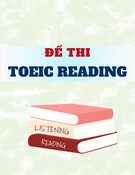

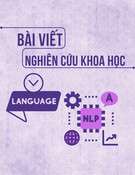


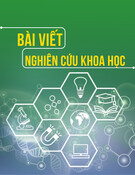
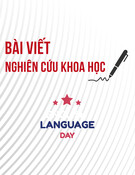

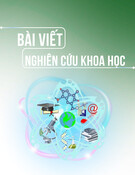

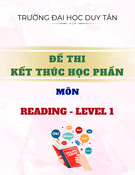
![Đề cương môn Tiếng Anh 1 [Chuẩn Nhất/Mới Nhất]](https://cdn.tailieu.vn/images/document/thumbnail/2025/20251130/cubabep141@gmail.com/135x160/51711764555685.jpg)
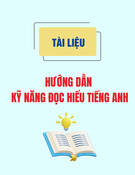

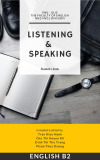
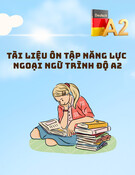

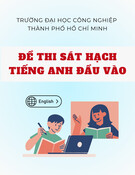
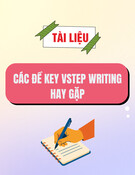

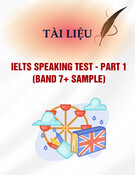

![Mẫu thư Tiếng Anh: Tài liệu [Mô tả chi tiết hơn về loại tài liệu hoặc mục đích sử dụng]](https://cdn.tailieu.vn/images/document/thumbnail/2025/20250814/vinhsannguyenphuc@gmail.com/135x160/71321755225259.jpg)
